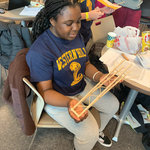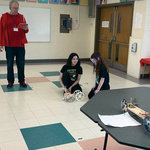By KELLSIE KING On Saturday, March 30, middle and high school students from across the state gathered at Rhode Island College in Providence for the 2019 RI Science Olympiad tournament. The tournament included 23 events in which teams participated. While
This item is available in full to subscribers.
We have recently launched a new and improved website. To continue reading, you will need to either log into your subscriber account, or purchase a new subscription.
If you are a current print subscriber, you can set up a free website account by clicking here.
Otherwise, click here to view your options for subscribing.
Please log in to continue |
|



On Saturday, March 30, middle and high school students from across the state gathered at Rhode Island College in Providence for the 2019 RI Science Olympiad tournament. The tournament included 23 events in which teams participated.
While schools from all across the state competed, the schools from Cranston included both Cranston High School East and West, Hope Highlands Middle School, Hugh B. Bain Middle School and Western Hills Middle School.
Cranston West placed third in the statewide tournament for Division C, which included the high schools. The first- and second-place winners for the division were Barrington High School and Smithfield High School, respectively.
“Cranston West was third, and earned a trophy,” said James Magyar, co-director of the RI Science Olympiad program. “The students were really excited.”
One of the events in which both Cranston East and Cranston West participated was the Mousetrap Vehicle Run. The students from West who launched the car – named “The Zombie Apocalypse” – and completed the experiment were sophomores Lauren Kasegian and Julia Wasilewski.
According to Cameron Hahn, a senior at West, the team had to build a car that had one to two mousetraps. With this car and its contraptions, the team had to use the launched car to move a cup exactly eight meters away from the starting point, then measure the distance between the cup and the final point and multiply by two, according to Hahn.
The team’s vehicle was made out of 3D-printed wheels and glued balsa wood, along with basswood. There was a string attached to the back axle that would work in conjunction with the launched mousetraps. According to Garrett Doidge, another senior from Cranston West, they measured the distance of the vehicle using the amount of rotations the wheels made, which in this case, was 12.5 meters.
Another student who participated in the mousetrap experiment was Rose Lovenbury, a junior at Cranston East. Her vehicle used CDs as wheels, and she said she used a mousetrap vehicle kit and wood glue. She added that she included two dowels on the sides of her car.
Lovenbury said while the car didn’t move during her first run, during the second run she attached a trigger. She added that the cup was too short for where the dowels move.
Another event that occurred during the tournament Saturday was Battery Buggy. According to Magyar, Hope Highlands was third in this event. Western Hills also participated in the event for Division B, which was for middle schools. According to Matthew Rego, a seventh-grader at Western Hills, the goal was to get the buggy to 10 meters distance. He said that they based this year’s buggy on the team’s buggy from last year. Their buggy was made out of levers, switches, CDs and batteries, said Rego.
Another event in which Western Hills participated was Boomilever, in which a structure is put on a wall and has to hold its own weight, according to eighth-grader Semiha Salami. She said that there was a “certain limit to what it can hold” and that they tried 15,000 kilograms. Salami said that she was helped by fellow eighth-grader Christian Ranallo to build it. According to seventh-grade student Alex DiLorenzo, they made the structure using light wood.
“It was fun to do,” Salami said.
Maya Lane, a junior at Cranston East, said she participated in the Experimental Design, Codebusters and Fossils events. She said that during the experimental design event, she had to design an experiment and make sure to incorporate all parts into it.
Lane said she used M&Ms shells to represent the shells of beetles, then crushed shells to see the superiority of dominant beetles. She added that this was “relative to the position in the experiment.”
Sophia Tomaselli, a sophomore at Cranston East, participated in Mission Possible, in which where students had to create a contraption that would allow a battery to rise 20 centimeters on a platform. She said she used a pulley system and a ping pong ball to help make the battery rise. She built the creation in two days after school.
“It completed what it needed to,” she said. “It was a lot of trial and error.”
Magyar said that while Cranston middle schools did not earn trophies for the teams, Hope Highlands and Western Hills placed in the events.
“Hope Highlands was first in Meteorology, second in Game On, and third in Battery Buggy,” he said in an email. “Western Hills earned silver in Circuit Lab and in Dynamic Planet and bronze in Solar System.”
Magyar said that the first-place winners in each division go on to compete at the national tournament, which is being held at Cornell University in Ithaca, New York, this year. He said that while Rhode Island teams have not won the tournament, “individual students have earned medals from time to time.”
Cranston West team coach Christopher Martineau expressed his pride in the team’s success and the dedication of the students in an email Monday.
“I am very proud of my team and it meant so much to them and me,” he said. “We haven't finished in the top three for five or six years. The students on the team organized everything and took pride in this team.”
He went on to acknowledge how the students pushed for improvement by including extra hours of work. He said that the students wanted to improve their performance in the tournament, and without them the success would not be possible.
Martineau said that the Cranston West team earned medals in certain events – bronze in Astronomy and silver in Boomilever and Thermodynamics.
“All the events are challenging in their own way and are different every year,” Martineau said.
Magyar said the Science Olympiad program “provides a fun way for students to learn science” and collaborate with fellow students who enjoy the subject. He added that many alumni of the program have ended up going into a career in the scientific field.
Comments
No comments on this item Please log in to comment by clicking here